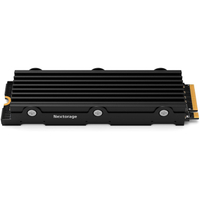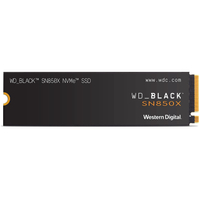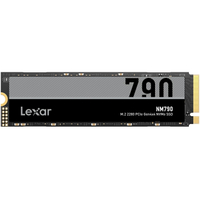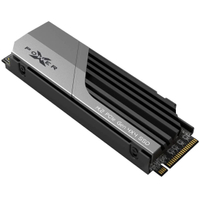Quick menu
⚙️ The list in brief
1. Best overall
2. Best budget
3. Best 2TB+
4. Best for Steam Deck
5. Best for PS5
6. How to spot the best deal
7. How we test
8. FAQ
Experience lightning-fast loading screens with the best M.2 SSD for gaming. This reliable upgrade enhances your day-to-day PC usage, as not only does an M.2 NVMe SSD provide a much faster overall experience than other types of drive, but it’s also one of the most affordable upgrades you can make for your PC.
The best M.2 SSD for gaming on the market is the WD Black SN850X. It comes with a great blend of performance and affordability that’s great for PC gaming. However, when it comes to affordability we’re also big fans of the supremely good-value and surprisingly fast Lexar NM790 , which makes our top recommendation for the best budget M.2 SSD.
We’re constantly conducting extensive testing to identify the top NVMe SSDs for PC gaming. While a 512GB drive may seem tempting for the money, it may not be worth it given the size of modern PC games, so 1TB to 2TB is considered something of a sweet spot. We still recommend Gen 4 drives over Gen 5, as currently there’s little real world advantage over the latest versions, but if that changes we’ll update this guide to reflect it.
Curated byCurated byJeremy Laird
Jeremy likes CPUs. And GPUs. And SSDs. A lot. Which is just as well, since he’s been writing about them since the early Mesozoic period. Or at least since Intel released those early stuttering SSDs. Remember them? Good times.
The quick list
Best overall
1. WD Black SN850X
Best overall
The WD Black SN850X is something of a last hurrah for Gen 4 SSDs, and it’s still the best overall NVMe drive out there right now.
Best budget
2. Lexar NM790
Best budget
The Lexar NM790 is a very fast Gen 4 SSD from a respected manufacturer that costs a lot less than you might expect, while making very few real-world compromises.
Best 2TB+
3. Nextorage NEM-PA
Best high capacity
If you need huge amounts of speedy storage without breaking the bank, then the Nextorage NEM-PA NVMe makes for an excellent pick. Big sizes, relatively small prices, and superb performance.
Best for Steam Deck
4. Sabrent Rocket 2230
Best for Steam Deck
To boost your Steam Deck’s capacity, you’ll need a 2230 drive such as this one from Sabrent. It offers great performance and importantly is available in massive storage capacities compared to the standard Deck options.
Best for PS5
5. Silicon Power XS70 2TB SSD
Best for PS5
Armed with the latest Phison controller and high-performance NAND flash memory, a drive like the Silicon Power XS70 is a fearsomely fast drive for Sony’s PlayStation 5.
Recent updates
This page was updated on February 28 with some tweaks to the intro and to update the reviews and recommendations.
The best M.2 SSD
Image 1 of 3
1. WD Black SN850X
Our expert review:
Specifications
Capacity: 500GB, 1TB, 2TBController: WD in-house (SanDisk)Memory: 112-layer TLCInterface: PCIe Gen4 x4Seq. read: 7,300MB/sSeq write: 6,300MB/s
Reasons to buy
+Runs much cooler than SN850+Great all-round performance+All the Gen 4 SSD you’ll ever need
Reasons to avoid
-Not a major step forward-No real gains in 4K random performance-Heat sink adds cost
Our favorite WD Black SN850X config:
<a href=”https://target.georiot.com/Proxy.ashx?tsid=8432&GR_URL=https%3A%2F%2Famazon.com%2FWD_BLACK-SN850X-Internal-Gaming-Solid%2Fdp%2FB0B7CMZ3QH%3Ftag%3Dhawk-future-20%26ascsubtag%3Dhawk-custom-tracking-20″ data-link-merchant=”Amazon US”” target=”_blank”>WD_Black SN850X | 2TB | 7,300MB/s read | 6,600MB/s write
The 1TB version is a great shout if you’re after an affordable, but fast, SSD. But the 2TB drive is a decent price with regular discounts that often price it below the competing Samsung or SK Hynix drives.
View DealBuy if…
✅If you want a great all-rounder: The SN850X has a winning combination of great speeds, cool running and affordability that’s difficult to beat.
✅ If you don’t want to worry about temps: Whether you go for the heatsink model or not, the WD Black SN850X stays chilled out.
Don’t buy if…
❌ You want the absolute cutting edge of performance: There are slightly faster drives, or much faster if you go for Gen 5, but realistically this is all the real-world speed you’re going to need for the time being.
The regular SN850 was one of our favourite drives, but since the WD Black SN850X arrived it took our top spot for the best NVMe SSD overall, and has stayed there ever since.
So what sets it apart from the pack? Well, while it might have some of the standard features of a regular Gen 4 NVMe drive, what with its four lanes of PCIe connectivity and the expected M2 2280 form factor, it sports some shiny new additions to the board that add some serious performance credentials.
WD’s own controller has had some revisions, alongside an upgrade from 96-layer TLC NAND memory chips to newer 112-layer models. And if those sort of specs make your eyes cross, have no fear, for we shall interpret them for you: It means performance. Lots and lots of it.
The 1TB model delivers read speeds of 6,300MB/s, and write speeds of 7,300MB/s. That’s plenty fast, and while it puts it in contention with some of the very faster Gen 4 drives we’ve tested, there are slightly faster. Two things on that point: Firstly, when it comes to small differences in synthetic SSD benchmarks, you’re absolutely not going to be able to tell the difference in real world drive usage. And two?
With the WD Black SN850X, you’re not just getting great speeds, you’re getting the whole package.
Let’s talk temperatures for a moment. Simply put, like many components, if your NVMe gets too hot under sustained usage then it throttles itself back to save itself from potential damage. The WD Black SN850X, however, runs remarkable cool under load, particularly if you pick the model with the WD signature armour-style heatsink.
We found our review unit never breached 58°C under sustained load, which is a big improvement over the standard SN850 and its 77°C.
That should give some peace of mind that you’re getting the best performance out of your drive even under heavy usage, although even the non-heatsink model performs decently when it comes to temperature throttling.
You also get WD’s Game Mode drive management software. The company claims this improves your gaming load times thanks to some clever algorithms. Pretty hard to test, that one, but we found the WD Black SN850X did extremely well in our game loading benchmarks, so it may very well be adding something to the pot. A nice feature to have, at the very least.
And finally, there’s price. While the Lexar NM790 below can often be found cheaper and still makes our best budget recommendation for the excellent performance it provides, the WD Black SN850X has been around for a little while now, and goes on discount on the regular. You might have to wait around a bit to find the best deal, but they are out there, and all the sweeter for it.
Any drawbacks? Well, the 4K random access results weren’t stellar, although you’d only really see that on the benchmarks. It’s real world performance you’re likely to care about most, and here the SN850X performed brilliantly.
It’s an all-round performer, and a completely solid overall choice for anyone looking for an NVMe SSD that hits all the right notes. Cool, efficient and plenty fast. What more do you really need?
Read our full WD Black SN850X SSD review.
The best budget M.2 SSD
Image 1 of 3
2. Lexar NM790
Our expert review:
Specifications
Capacity: 1TB, 2TB, 4TBController: MaxioTech MAP1602AFlash: YMTC 232-layer TLCInterface: M.2 PCIe 4.0 x4Seq. read: 7,400 MB/sSeq. write: 6,500 MB/s
Reasons to buy
+A range of high capacity options+Superb performance+Plenty fast enough for games and more+Runs cool
Reasons to avoid
-Less known controller/flash combo
Our favorite Lexar NM790 config:
<a href=”https://target.georiot.com/Proxy.ashx?tsid=8432&GR_URL=https%3A%2F%2Famazon.com%2FLexar-Internal-Compatible-Creators-LNM790X001T-RNNNU%2Fdp%2FB0C9213GBX%2F%3Ftag%3Dhawk-future-20%26ascsubtag%3Dhawk-custom-tracking-20″ data-link-merchant=”Amazon US”” target=”_blank”>Lexar NM790 | 1TB | 7,400MB/s read | 6,500MB/s write
Fast, affordable and from a respected brand, and it even runs cool to boot. As budget performers go, you don’t get any better than the little Lexar, and we were mightily impressed when we gave one a review.
View DealBuy if…
✅If you want top end performance for less: The Lexar NM790 is damn near as fast as the top Gen 4 performers, but regularly comes in significantly cheaper
✅ If you don’t want a heatsink: We tested the heatsink-less model, and found its thermal performance was great, making it a very good laptop or small form factor solution.
Don’t buy if…
❌ You’d prefer some more known components: The controller and flash combination here is a bit of an anomaly, but we’ve had no problem with the drives we tested and are still using long term. Still, if cheaper components bother you, you might want to look elsewhere.
Cheap and cheerful? How about cheap and still delivering excellent performance? The Lexar NM790 is a fantastic SSD that makes very few compromises while still remaining very affordable, and that means it sits proudly as our top budget NVMe drive recommendation.
If you’re in the market for a budget NVMe SSD, chances are you’ve been working under the assumption that you’ll have to take some performance penalties in order to save some cash. Not so with the Lexar NM790, as it delivers read and write speeds that any Gen 4 drive would be proud of.
Rated at 7,400MB/S sequential reads and 6,500 writes, this drive impressed us mightily when we reviewed the 4TB version, but you’ll be pleased to find it comes in a range of capacities including a very attractively priced 1TB model. But how come you can get all this performance and capacity for less?
Well, it comes down to the use of a lesser known controller and flash memory combo, the MaxioTech MAP1602 and YMTC 232-layer TLC respectively. Before you start worrying that maybe these lesser known components will under-perform however, allow us to put your minds at rest. While the Lexar has made some concessions in the name of budget, when it comes to performance, it stands alongside some of the very best drives we’ve tested.
Whether its synthetic benches or real world gaming tests, the NM790 performs admirably, all the while running cool, calm and collected. It makes use of a large SLC cache buffer that allows it to put in numbers that compete with the best Gen 4 drives, and that’s a very neat party trick to bring to the table.
More than that, the Lexar makes for an efficient drive no matter which way you look at it. While there are heatsink models available, we tested the heatsink-free version and found that its thermal performance was admirable, which is no mean feat, so there’s really no need to spend up unless you really want to make double-sure that it’ll deliver its full speeds without throttling.
Every now and then a component arrives that, thanks to some clever lateral solutions, runs rings around a lot of the competition while delivering great performance for less cash, and that’s exactly what we’ve got here. We regularly see 1TB models retailing for around $80 and 2TB models around the $130 marker, and that’s a genuine bargain for such a performant SSD.
Not only is it a budget champion, the mighty Lexar, but it can keep up with the big names without breaking a sweat.
Read our full Lexar NM790 4TB review.
The best high capacity M.2 SSD
Image 1 of 5
3. Nextorage NEM-PA
The best high capacity NVMe SSD
Our expert review:
Specifications
Capacity: 1TB, 2TB, 4TBController: Phison E18Flash: TLC NANDInterface: M.2 PCIe 4.0 x4Seq. read: 7,300MB/sSeq. write: 6,900MB/s
Reasons to buy
+Strong all-round performance+Runs super cool+Very competitively priced
Reasons to avoid
-Slightly disappointing PC Mark results-4K numbers are unspectacular
<a href=”https://target.georiot.com/Proxy.ashx?tsid=8432&GR_URL=https%3A%2F%2Famazon.com%2FNextorage-Internal-Expansion-NEM-PA2TB-SYM%2Fdp%2FB09RN23L75%2F%3Ftag%3Dhawk-future-20%26ascsubtag%3Dhawk-custom-tracking-20″ data-link-merchant=”Amazon US”” target=”_blank”>Nextorage Japan | 2TB | 7,300MB/s read | 6,900MB/s write
It might not have the brand recognition of its rivals, but the Nextorage NVMe SSD has a truly remarkable amount of performance and capacity, and can be found for very good prices too. This version comes with a substantial heatsink, but versions without are available for small form factor and laptop applications.
View DealBuy if…
✅You’re looking for oodles of space: The Nextorage NEM-PA comes in a variety of sizes, but we particularly like the 2TB and 4TB versions for the money. Speaking of which…
✅ You don’t want big prices for big sizes: We see the Nextorage drives on discount all the time, however, even at regular retail prices they represent huge value for money.
Don’t buy if…
❌ You want high speeds from every possible angle: The Nextorage NEM-PA drives have absolutely fantastic real-world performance, but benchmark hounds will notice the 4K numbers and PC Mark synthetic results are a little behind the pack.
Looking for lots and lots of storage, with no compromises on performance and for a great price? You’d struggle to do better than this Nextorage drive, which comes in a variety of well-priced high-capacity specifications, making it an easy pick for the best high-capacity NVMe drive in this list.
If you’re unfamiliar with the name, we don’t really blame you. In a market dominated by big players with heavy brand recognition, Nextorage is still the new kid on the block, although make no mistake, it still comes with a pedigree you might not expect.
See, Sony initially created Nextorage to manufacture SSD drives for its PlayStation consoles, until Phison, creator of some of the fastest storage controllers in the business, took a controlling stake in the company.
Soon after, Nextorage debuted drives making use of the Phison E18 controller, and it’s the very same chip that graces some of the fastest drives we’ve had the pleasure to review.
So, as you’d expect, this drive is quick. Very quick. We tested the 2TB model and found that it was an excellent performer, demonstrating read and write speeds that put many drives to shame. It’s rated for 7,300MB/s reads and 6,900MB/s writes and delivers them with aplomb, but it also managed to sustain 625GB of writes before dropping performance, thanks to the fact that a full one third of the NAND flash can be used in high-speed SLC cache mode.
Still, it’s not just performance you’re looking for here, its capacity, and when it comes to the 2TB and 4TB versions of these drives performance remains very similar between the two, while also often demonstrating a very competitive price compared to the closest competition.
SSD prices have been on the rise recently, but we still regularly see these capacious drives at prices that make you do a double-take. That makes them a fantastic way of adding huge amounts of lightning-fast storage capacity to your machine without breaking the bank.
You’ll find variants using very substantial heatsinks and some with none at all, but if you’ve got the room for it in your machine we’re happy to report that the heatsink version runs remarkably cool. Still, if you’re looking for something more compact then the heatsink-less models should still run plenty cool, which means they’ll be delivering great performance even in a laptop configuration.
Big storage, big performance, very competitive prices. Yep, Nextorage may not have made a name for itself just yet, but with this sort of hardware, it really won’t be long.
Read our full Nextorage NEM-PA 2TB review.
The best SSD for Steam Deck
Image 1 of 4
4. Sabrent Rocket 2230
The best Steam Deck 2230 NVMe SSD
Our expert review:
Specifications
Capacity: 256GB, 512GB, 1TBController: Phison E21Flash: 177-layer TLC NANDInterface: M.2 PCIe 4.0 x4Seq. read: Up to 5,000MB/s Seq. write: Up to 4,300MB/s
Reasons to buy
+Real world performance trumps the Deck+Smaller capacities don’t tank the battery
Reasons to avoid
-Inconsistent at 1TB…-and with higher power draw
Our favorite Sabrent Rocket 2230 config:
<a href=”https://sabrent.com/products/sb-2130-512″ data-link-merchant=”sabrent.com”” target=”_blank”>Sabrent Rocket 2230 | 512GB | 5,000MB/s read | 3,700MB/s writes
The 512GB drive is probably the sweet spot upgrade for anyone with either the 64GB or 256GB Steam Deck. You get both more space for your games as well as faster performance and lower power to help eke out a little bit more battery life.
View DealBuy if…
✅You’re looking for a Steam Deck upgrade: Any of these drives will be faster than the unit in the Steam Deck, and given the prices they make a relatively cheap storage upgrade over buying a high-capacity Deck in the first place.
✅ Smaller models sip power: Given we’re talking portable gaming, power draw is an important factor, and it was only the 1TB version that we spotted drinking a little heavily from the battery.
Don’t buy if…
❌ You want a 1TB drive with no caveats: Make no mistake, the 1TB version is still an excellent upgrade, but we did get some inconsistent load-time results, and it did drain the battery a little heavier than the others we tested.
If you’ve taken the plunge and bought yourself a Steam Deck, you may have encountered a common issue: The cheaper Decks make for great gaming machines, but can come with pretty limited storage capacity.
If you don’t mind breaking out a screwdriver and voiding the warranty (you’re absolutely sure about this, right?) then there are a few different drives in the 2230 form factor to consider, but we’ve found no better than the Sabrent Rocket 2230 NVMe SSD, and that makes it our recommendation for the best upgrade for Steam Deck storage.
The Sabrent drives come in 256GB, 512GB, and 1TB capacities and retail at $50, $90, and $170 respectively. That’s still a fair bit of cash to pay for these sort of capacities, but given that the competition is priced similarly and you’re limited to this form factor, it still represents good value for what you eventually receive.
The 256GB is rated to 4,640MB/s reads and 1,900MB/s writes, whereas the 512GB is meant to be closer to 5,000MB/s reads, and 3,700MB/s writes. The 1TB is a little slower with 4,750MB/s reads, but delivers faster 4,300MB/s write speeds. Each is still quicker than the regular SSD you’d find in a Steam Deck however, and that combined with the increased capacity is really what you’re paying for here.
If you’re currently slogging away with a 64GB Steam Deck and carefully managing your install options then upgrading to the 256GB or the 512GB Sabrent drive gets you much more capacity and a lot more performance, making it a very worthwhile upgrade, especially when you compare it to the price of buying a larger capacity Steam Deck in the first place.
Mobile gaming has come a long way, but storage capacity is still one of the areas where we could see some reasonable improvements in the default specifications. Get ahead of the curve and do it yourself and you can reap the benefits, and these Sabrent drives make the most sense as worthy additions to your beloved Deck.
Read our full Sabrent Rocket 2230 review.
The best M.2 SSD for PS5
5. Silicon Power XS70 2TB SSD
Our expert review:
Specifications
Capacity: 1TB, 2TB, 4TBController: Phison PS5018-E18Flash: Micron 176L TLC NANDInterface: M.2 PCIe 4.0 x4Seq. read: 7,300MB/sSeq. write: 6,800MB/s
Reasons to buy
+Attractive heatsink+PS5 compatible+Excellent performance+Price competitive
Reasons to avoid
-Lacks software
Our favorite Silicon Power XS70 SSD config:
<a href=”https://www.newegg.com/p/0D9-0021-00138?item=9SIBDGPJGE1756&nm_mc=AFC-RAN-COM&cm_mmc=afc-ran-com-_-Future+Publishing+Ltd&utm_medium=affiliate&utm_campaign=afc-ran-com-_-Future+Publishing+Ltd&utm_source=afc-Future+Publishing+Ltd&AFFID=2294204&AFFNAME=Future+Publishing+Ltd&ACRID=20851877214&ASUBID=hawk-custom-tracking&ASID=https%3A%2F%2Fpreview.vanilla.tools%2Ffte%2Fpcgamer%2F8b9d476e-9dad-11ed-b529-8a482473ff6c%2Fbest-nvme-ssd&ranMID=44583&ranEAID=2294204&ranSiteID=kXQk6.ivFEQ-Oi0J0VJpp_ygi_JoM6pDWA” data-link-merchant=”newegg.com”” target=”_blank”>Silicon Power 2TB XS70 | 2TB | 7,100MB/s read | 6,600MB/s write
The 2TB model comes at a very competitive price and works well as an expansion drive for the PlayStation 5.With excellent read/write speeds and an attractive and great-performing heatsink, it makes an excellent choice for those looking to upgrade the consoles storage to something faster.
View DealBuy if…
✅You’re looking for the best drive for your PS5 : Several SSDs have been built to fit in a PlayStation 5, but this one stands out with its excellent thermals and speeds despite its small heatsink.
✅ If you want a set and forget solution: The Silicon Power XS70 is a no-fuss solution to a potentially fussy problem. It’s an all-round great drive for the PS5 that fits in perfectly with no major caveats.
Don’t buy if…
❌ You want included software for a PC install: The XS70 makes for an excellent PC SSD as well, but if you’re looking for cloning software or indeed, any SSD software at all, you’ll want to find a third-party solution.
While the PlayStation 5 does make use of a rather snazzy Gen 4 drive, there will be many of you hoping to fit your console with something larger to fit as many games as possible on to your shiny console machine of dreams. That being the case, we recommend the Silicon Power 2TB XS70 as our top pick for the best PS5 NVMe SSD.
For a start, it’s a superb performer. Thanks to some Micron 176-layer TLC NAND and a controller that needs little introduction, the Phison E18, alongside 2GB of DDR4 RAM, the XS70 makes for a potent drive in any setup with the appropriate M2 slot. 7,300MB/s sequential reads and 6,800MB/s writes puts it well up there with some of the faster drives we’ve tested, along with some excellent random read performance.
But honestly, if you’re just looking for a big and powerful drive to stick straight into your PS5, close the casing and forget about it, you’re going to ideally want something designed with PlayStation compatibility in mind, and that’s exactly what Silicon Power has created here.
There’s no hardware encryption on offer, but really what you need is great performance and well-controlled thermals, and the PlayStation 5 compatible heatsink here is a superb performer in that regard. It’s very efficient, and we saw top temps of a mere 63°C, which is a great result for a Gen 4 drive with this level of performance.
It’s small packaging reminds us of a flash drive, but when it comes to what this drive is capable of delivering then a simple USB stick this is not. Those of you planning on installing one in a PC may bemoan the lack of software support ecosystem, but console users will care not one jot.
You’ll simply want a very fast drive in the right form factor that you can set, forget, and use on the regular to keep your PlayStation stocked with games, and here Silicon Power have really judged the market very well indeed.
It’s not big, but it is clever, and if you really want to make the most of your console experience by installing a very fast drive designed to sit right at the heart of your PS5 without a single complaint, then this right here is the SSD for you.
Read our full Silicon Power 2TB XS70 review.
How to spot the best deals
How we test NVMe SSDs
We put every SSD we get in the PC Gamer labs through their paces in various benchmarks made up of a mix of synthetic tests and real-world applications. To ascertain a drives sequential throughput, we use ATTO SSD Benchmark for compressible data (a best-case scenario) and AS SSD for incompressible data (more realistic). We also test random throughput with AS SSD and a combination of CrystalDiskMark 7.0 and Anvil Pro.
When it comes to the real-world tests, we time how long it takes to copy a 30GB game install across the drive and use PCMark10 and Final Fantasy XIV: Shadowbringers, which includes a level load test.
We also check operating temperatures to ensure that the drive isn’t getting too hot and throttling. That’s becoming more of an issue with faster and faster drives. PCIe 5.0 drives appear to require a lot more cooling than previous generations, which does make you wonder if the extra speed is really worth it yet.






